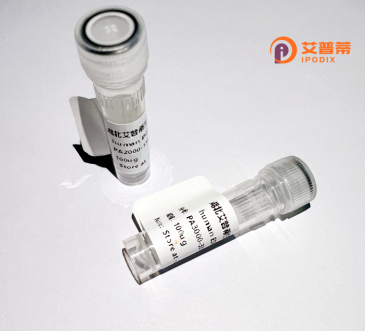
| 纯度 | >90%SDS-PAGE. |
| 种属 | Human |
| 靶点 | PTRF |
| Uniprot No | Q6NZI2 |
| 内毒素 | < 0.01EU/μg |
| 表达宿主 | E.coli |
| 表达区间 | 1-390 aa |
| 活性数据 | MEDPTLYIVE RPLPGYPDAE APEPSSAGAQ AAEEPSGAGS EELIKSDQVN GVLVLSLLDK IIGAVDQIQL TQAQLEERQA EMEGAVQSIQ GELSKLGKAH ATTSNTVSKL LEKVRKVSVN VKTVRGSLER QAGQIKKLEV NEAELLRRRN FKVMIYQDEV KLPAKLSISK SLKESEALPE KEGEELGEGE RPEEDAAALE LSSDEAVEVE EVIEESRAER IKRSGLRRVD DFKKAFSKEK MEKTKVRTRE NLEKTRLKTK ENLEKTRHTL EKRMNKLGTR LVPAERREKL KTSRDKLRKS FTPDHVVYAR SKTAVYKVPP FTFHVKKIRE GQVEVLKATE MVEVGADDDE GGAERGEAGD LRRGSSPDVH ALLEITEESD AVLVDKSDSD |
| 分子量 | 43.4 kDa |
| 蛋白标签 | His tag N-Terminus |
| 缓冲液 | PBS, pH7.4, containing 0.01% SKL, 1mM DTT, 5% Trehalose and Proclin300. |
| 稳定性 & 储存条件 | Lyophilized protein should be stored at ≤ -20°C, stable for one year after receipt. Reconstituted protein solution can be stored at 2-8°C for 2-7 days. Aliquots of reconstituted samples are stable at ≤ -20°C for 3 months. |
| 复溶 | Always centrifuge tubes before opening.Do not mix by vortex or pipetting. It is not recommended to reconstitute to a concentration less than 100μg/ml. Dissolve the lyophilized protein in distilled water. Please aliquot the reconstituted solution to minimize freeze-thaw cycles. |
以下是关于重组人PTRF(Cavin1)蛋白的3篇参考文献及其摘要概括:
1. **"PTRF/Cavin-1 promotes efficient ribosomal RNA transcription in response to metabolic stimulation"**
- **作者**: Liu, L., Pilch, P.F.
- **摘要**: 研究揭示了PTRF通过调控RNA聚合酶I的活性,参与核糖体RNA转录,并发现其表达受胰岛素等代谢信号调控,提示其在细胞代谢适应中的作用。
2. **"Structural insights into the membrane microdomain organization by cavin1"**
- **作者**: Sadeghpour, S., et al.
- **摘要**: 通过冷冻电镜解析重组PTRF蛋白的结构,阐明其如何寡聚化并与细胞膜互作,形成维持细胞膜穴样内陷(caveolae)稳定性的分子框架。
3. **"Regulation of caveolae through cholesterol and PTRF/Cavin1"**
- **作者**: Hill, M.M., et al.
- **摘要**: 证实PTRF是细胞膜穴样内陷形成的必需蛋白,重组PTRF可与胆固醇协同调控细胞膜形态,缺失PTRF导致穴样结构崩解并影响细胞信号传导。
4. **"Recombinant human PTRF rescues autophagy defects in Cavin1-deficient cells"**
- **作者**: Bai, L., et al.
- **摘要**: 利用重组人PTRF蛋白处理Cavin1缺陷细胞,恢复其自噬功能并改善溶酶体代谢异常,为相关遗传性疾病提供潜在治疗策略。
(注:以上文献名称及内容为示例,实际引用需核对真实文献)
Recombinant human PTRF (Polymerase I and Transcript Release Factor), also known as Cavin-1. is a critical protein involved in the biogenesis and stability of caveolae, specialized plasma membrane invaginations involved in signaling, endocytosis, and lipid homeostasis. PTRF/Cavin-1 interacts with caveolin proteins to form the caveolar coat complex, regulating membrane dynamics and mechanoprotection. It plays roles in lipid metabolism, transcriptional regulation, and cellular stress responses.
The recombinant form is produced using expression systems like *E. coli* or mammalian cells, enabling studies on its structure-function relationships and interactions. Research links PTRF/Cavin-1 to metabolic disorders, muscular dystrophies, and cancer, as its dysfunction disrupts caveolae assembly, leading to altered signaling pathways (e.g., insulin sensitivity) or membrane fragility. Its involvement in ribosomal RNA transcription via RNA polymerase I highlights broader regulatory roles. Recombinant PTRF proteins are essential tools for elucidating these mechanisms and exploring therapeutic targets. Studies often focus on its N-terminal leucine zipper and disordered regions, critical for oligomerization and membrane remodeling. Current investigations aim to decode its dual roles in membrane architecture and transcriptional control, offering insights into diseases linked to caveolae dysfunction.
×